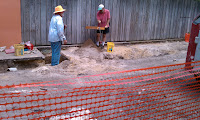Today's fieldtrip reminded me that you just never know what's in store in historic St. Augustine. Not knowing quite where I wanted to go today, I decided to drop by historic Aviles Street and see the remodeling work going on there. Doesn't sound too exciting, does it? Well I was in for a surprise! When I got out there, I saw City Archaeologist Carl Halbirt and one of his volunteers excavating a unit on the east side of the street.
 |
| Volunteer Nick talks to visitors. Layers of road are to his left. |
In the spring, when the City decided to remodel Aviles Street and widen sidewalks, Halbirt was called in to investigate the areas that were going to be disturbed. He and his volunteers opened up some test units and, before it was all over, documented 15 historic road layers. The layers dated from modern pavement to road beds from the early 1600s, proving that Aviles is one of the oldest streets in the country. They also discovered a midden (or trash deposit) and evidence of a 19th-century structure. Most interesting of all, they found a layer of charcoal and burned material that dated to 1702, when the British attacked and burned the city.
 |
| Above trowel: thick gray road layer, thin darker lens, & coquina sidewalk. |
So what on earth were they doing out there today? I stood behind the orange fencing taking pictures of the dig and Carl waved me over. He told me that they were monitoring (watching construction activity in case anything of interest turns up) and discovered an interesting coquina layer. So they opened up a small unit where the modern sidewalk stands to figure out what it was. They found out that the crushed coquina was a sidewalk dating to the late 19th century. Not only that, but directly below the coquina was a thin layer of road and a thicker layer of road, also from the same time period. According to Halbirt, it looks like those three layers were deposited within a span of about 25 years. It was funny to think about that historic street as having once been wider, and even stranger to think about how the city is repeating that history, once again adding to the sidewalk.

I stuck around for a while to help screen artifacts. Of course we found lots of chunks of coquina and brick, but also some ceramics--whiteware and a Native American pottery called St. Johns. My favorite find was a 19th century toothbrush made of bone.
 |
| Halbirt sits next to the posthole feature writing fieldnotes. |
At the very bottom of the level, Carl came across a distinct change in soil color, called a feature. This feature was round, like a hole for a wooden post. Since it was so close to the road, Halbirt speculated that it could even be a hitching post. He put down his shovel and grabbed the biggest trowel I've ever seen--I called it the "clown trowel"--to examine it more carefully.
As they dig deeper, City Archaeology is also looking for remnants of Los Remedios parish church, which was in use from 1572 to 1702. The church and its property stood to the east of Aviles Street, but Halbirt hopes to determine whether it extended into what later became the roadway.

As for me, it was time to head back to work. I agreed with Nick, the volunteer, that it was indeed a very hot day to be out excavating. Then I left them there, digging and screening in the sun, and headed off to my next adventure...
 As for me, it was time to head back to work. I agreed with Nick, the volunteer, that it was indeed a very hot day to be out excavating. Then I left them there, digging and screening in the sun, and headed off to my next adventure...
As for me, it was time to head back to work. I agreed with Nick, the volunteer, that it was indeed a very hot day to be out excavating. Then I left them there, digging and screening in the sun, and headed off to my next adventure...


 As for me, it was time to head back to work. I agreed with Nick, the volunteer, that it was indeed a very hot day to be out excavating. Then I left them there, digging and screening in the sun, and headed off to my next adventure...
As for me, it was time to head back to work. I agreed with Nick, the volunteer, that it was indeed a very hot day to be out excavating. Then I left them there, digging and screening in the sun, and headed off to my next adventure...
